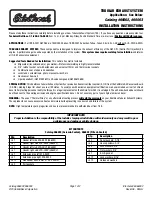
PRACTICAL INFORMATION
110
Uniform Tire Quality Grading
ALL PASSENGER VEHICLE TIRES MUST
CONFORM TO FEDERAL SAFETY REQUIRE-
MENTS IN ADDITION TO THESE GRADES
.
Quality grades can be found, where applica-
ble, on the tire sidewall between the tread
shoulder and maximum section width. For
example:
Treadwear 200 Traction AA Temperature A
TREADWEAR
The treadwear grade is a comparative rating
based on the wear rate of the tire when tested
under controlled conditions on a specified gov-
ernment test course. For example, a tire graded
150 would wear one and one half (1 ½) times as
well on the government course as a tire graded
100. The relative performance of tires depends
upon the actual conditions of their use, however,
and many depart significantly from the norm due
to variation in driving habits, maintenance practi-
ces and differences in road characteristics and
climate.
TRACTION
The traction grades, from highest to lowest, are
AA, A, B, and C, as measured under controlled
conditions on specified government test surfaces
of asphalt and concrete. A tire marked C may
have poor traction performance. The traction
grade assigned to this tire is based on braking
(straight-ahead) traction tests and is not a meas-
ure of cornering (turning) traction.
WARNING
The traction grade assigned to this tire is
based on braking (straight-ahead) traction
tests and is not a measure of cornering (turn-
ing) traction.
TEMPERATURE
The temperature grades are A (the highest), B,
and C, representing the tire's resistance to the
generation of heat and its ability to dissipate heat
when tested under controlled conditions on a
specified indoor laboratory test wheel. Sustained
high temperature can cause the material of the
tire to degenerate and reduce tire life, and exces-
sive temperature can lead to sudden tire failure.
The grade C corresponds to a minimum level of
performance that all passenger vehicle tires must
meet under the Federal Motor Safety Standard
No. 109. Grades B and A represent higher levels
of performance on the laboratory test wheel than
the minimum required by law.
WARNING
The temperature grade for this tire is estab-
lished for a tire that is properly inflated and
not overloaded. Excessive speed, under-infla-
tion, or excessive loading, either separately or
in combination, can cause heat buildup and
tire failure.
Snow tires and chains
The use of snow chains and/or winter tires can
help improve traction in winter driving conditions.
Snow chains can be used on your Volvo with the
following restrictions:
•
Snow chains should be installed on front
wheels only. Use only Volvo approved snow
chains.
•
If accessory, aftermarket or "custom" tires
and wheels are installed and are of a size dif-
ferent than the original tires and wheels,
chains in some cases CANNOT be used.
Sufficient clearances between chains and
brakes, suspension and body components
must be maintained.
•
Some strap-on type chains will interfere with
brake components and therefore CANNOT
be used.
•
All Wheel Drive models
: Snow chains
should only be installed on the front wheels.
•
Certain size tires may not allow the assembly
of snow chains/traction devices.
Consult your Volvo retailer for additional snow
chain information.
Summary of Contents for V90 2017
Page 1: ...OWNER S MANUAL SUPPLEMENT ...
Page 2: ......
Page 7: ...5 INDEX Index 177 ...
Page 8: ......
Page 9: ...INTRODUCTION ...
Page 50: ......
Page 51: ...IMPORTANT INFORMATION ...
Page 88: ......
Page 89: ...PRACTICAL INFORMATION ...
Page 149: ...FUSES ...
Page 156: ... FUSES 154 ...
Page 162: ......
Page 163: ...SPECIFICATIONS ...
Page 178: ......
Page 183: ......
Page 184: ...TP 23658 English USA Canada AT 1717 MY18 Copyright 2000 2017 Volvo Car Corporation ...
















































